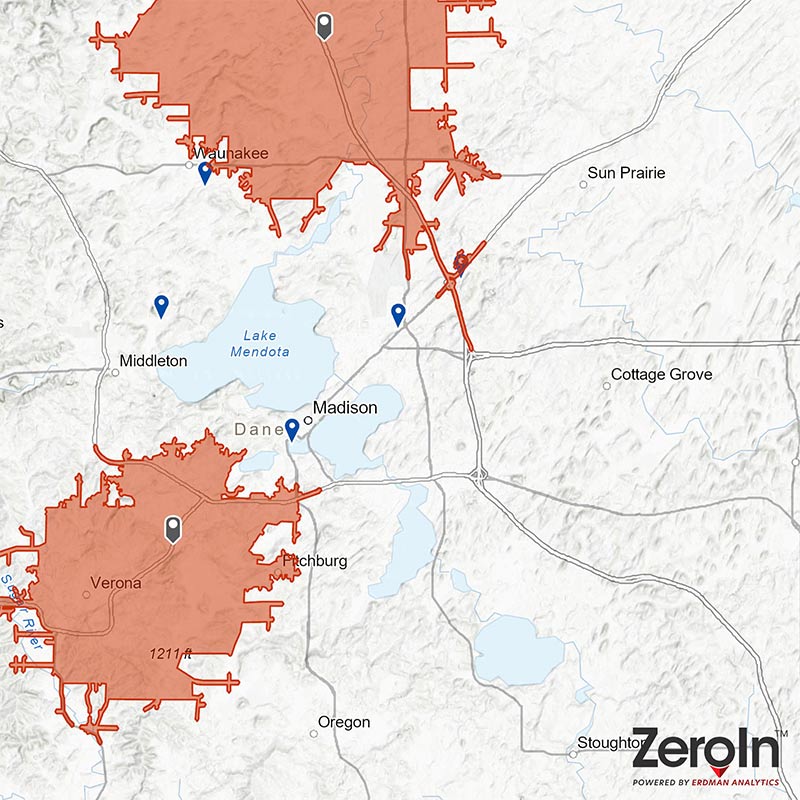Key Takeaway
Medicare Advantage (MA) turns 25 this year. With its annual election period recently ended, CMS expects a record 29.5 million seniors to enroll—up from 26.9 million in 2021.2 That is approximately 47% of the Medicare-eligible population.
Enrollment in MA plans has grown exponentially in recent years, representing a unique platform for healthcare systems and medical groups to differentiate on their approach to senior care services. STAR ratings alone do not facilitate meaningful MA plan comparisons. The scope of basic and supplemental services provided and the accessibility of reputable in-network hospitals and clinicians factor significantly in the decisions consumers make.
The first step in defining a successful strategy for Medicare Advantage enrollment growth is identifying viable geographic opportunities. ERDMAN’s ZeroInTM MA Attractiveness Index provides an objective basis for visualizing and quantifying opportunities in MA.
Background
- 58% (2,200) of the plans operate an HMO model, 1,100 (29%) operate a PPO model and the rest are hybrids of these major models.
- 60% of MA enrollees pay no supplemental premium5 (other than the Part B premium): 5% paid less than $20/mo., 17% paid $20-49/mo., 12% paid $50-99/mo. and 6% paid more than $100/mo.4
- Big investor-owned sponsors dominate covering 71% of enrollees: UnitedHealthcare and Humana account for 44% of total enrollment, Blue Cross affiliates (including Anthem BCBS plans) account for another 15%, CVS Health, Kaiser Permanente, Centene, and Cigna account for another 23%.4 Venture-backed health plans (i.e., Alignment, Clover, Bright, Devoted et al) account for approximately 241,000 lives (1% of national enrollment) and collectively added 64,000 lives last year.3
- 90% of plans include prescription drug coverage (MA Prescription Drug plans or MAPDs). Other popular benefits include: telehealth (94%), eye exams or glasses (79%), dental care (74%), fitness benefits (74%), hearing aids (72%), OTC medications (61%), meals (39%), transportation services (34%), and home care (4%).1
- MA grew 9.6% from 2020 to 2021 to 29.5 million enrollees, while enrollment in original Medicare fell 2.6%. Since 2011, penetration has increased 17 percentage points (25% to 42%) and enrollment has more than doubled.4
- 19% of enrollees are in group MA plans offered by employers and unions for their retirees, representing a disproportionately large share of MA enrollees in nine states: Alaska (100%), Michigan (49%), West Virginia (44%), New Jersey (40%), Wyoming (36%), Illinois (35%), Maryland (35%), Kentucky (34%), and Delaware (31%).4
- Enrollment varies widely by state, ranging from 1% (AK, WY) to over 40% in 24 states.4
- Enrollment varies widely by county, from less than 1% to more than 70%: in 117 mostly urban counties, accounting for 5% of the total Medicare population, more than 60% of all Medicare beneficiaries are enrolled in MA plans. Some urban areas, such as Baltimore City (20%) and Cook County, IL (Chicago, 28%) have low MA enrollment, compared to the national average (39%). In contrast, in 508 mostly rural counties, accounting for 3% of Medicare beneficiaries, no more than 10% of beneficiaries are enrolled in Medicare private plans; many of these low penetration counties are in rural parts of the country.4
Looking ahead, two major changes to MA:
In the coming months, regulatory changes will continue and increased competition may spur increased enrollment in the MA market:
Regulatory oversight:
Regulators are keen to examine risks associated with the health status of MA enrolled populations in relation to its fee-for-service enrolled population. The Office of Inspector General in HHS estimates Medicare overpaid $140 billion to 142 plans in the last decade as a result of systemic upcoding.6
Regulators also want to examine MA supplemental benefit programs like transportation, nutrition and housing that address social determinants of health especially important in under-served populations. CMS actuaries estimate supplemental benefits for chronically ill individuals will increase from 19% to 25% of MA spending as enrollment grows in populations previously not targeted by MA plans.2
Competition:
Incumbent sponsors like UnitedHealth and Humana face increased MA competition from new entrants like Devoted Health, Clover Care, Troy and Zing Health and others. Most of these have private equity backing (e.g., Devoted Health, the Boston-based e-MA plan founded by the Park brothers, completed its Series D funding October 8 landing, $1.15 billion from SoftBank, GIC, Andreessen Horowitz, Premji Invest, Maverick, Frist Cressey Ventures, NextView ICONIQ Growth, General Catalyst, the Base10 Advancement Initiative, and Emerson Collective). Most leverage sophisticated technology platforms to monitor enrollee and provider behaviors and segment their enrollees into discreet populations based on unique needs, preferences, habits, and propensity for self-care management.
Emergent Opportunities in MA
MA is a platform that can fully manage senior population health while leveraging healthcare facilities, whole-person care, and digital connectivity. Examples include:
Long Term Care:
adult day programs, in-home personal care services, benefits for over-the-counter products, and home safety modifications (e.g., bathroom grab bars, wheelchair ramps, stair rails, meal delivery and transportation, palliative care, and integrated hospice care). Notably, 4% of MA enrollees live in nursing homes or long-term rehabilitation facilities where MA-enhanced services are welcomed by resident families and administrators.
Community Health:
wellbeing and social services that address senior loneliness, nutrition, gaps in care, and unnecessary hospitalization.
Primary and Preventive Health:
‘medical homes’ where physical and mental health, prophylactic dentistry, nutrition, and social needs are integrated seamlessly utilizing an exclusive physician-patient dyad.

ERDMAN’s ZeroInTM MA Attractiveness Index: The Starting Point
ERDMAN uses its proprietary tools and methodology to identify population segments where MA enrollment growth has strong potential and plan deployment of services or providers customized to meet the unique needs, values, and preferences of local senior populations.
For more information, or to request a ZeroInTM demo, please contact the ERDMAN Advisory Services team at info@erdman.com.

Fig. 5A – Medicare Advantage Index with current locations

Fig. 5B – Medicare Advantage Index with current locations & potential expansion opportunities
1. Healthcare Payer Intelligence. (November 10, 2021). “Trends in Medicare Advantage 2022 Open Enrollment Offerings” healthpayerintelligence.com/news/trends-in-medicare-advantage-2022-open-enrollment-offerings
2. Centers for Medicare & Medicaid Services. (September 30, 2021). “CMS Releases 2022 Premiums and Cost-Sharing Information for Medicare Advantage and Prescription Drug Plans” www.cms.gov
3. Faegre Drinker. (October 25, 2021). “Medicare Advantage Benefit Trends for 2022: A First Glimpse” https://www.faegredrinker.com/en/insights/publications/2021/10/medicare-advantagebenefit-trends-for-2022-a-first-glimpse
4. Kaiser Family Foundation. (June 21, 2021 ). “Medicare Advantage in 2021: Enrollment Update and Key Trends” https://www.kff.org/medicare/issue-brief/medicare-advantage-in-2021-enrollmentupdate-and-key-trends/
5. Association of Community Health Plans. (January 12, 2021 ). “FACT SHEET — Medicare Advantage: The Choice Of America’s Seniors” www.achp.org
6. Paul Keckley — The Keckley Report. (October 25, 2021 ). “Three Major Policy Shifts In the 2020 Healthcare Regulatory Environment” https://www.paulkeckley.com/the-keckley-report/2021/10/25/three-major-policy-shifts-in-the-2022-healthcare-regulatory-environment



